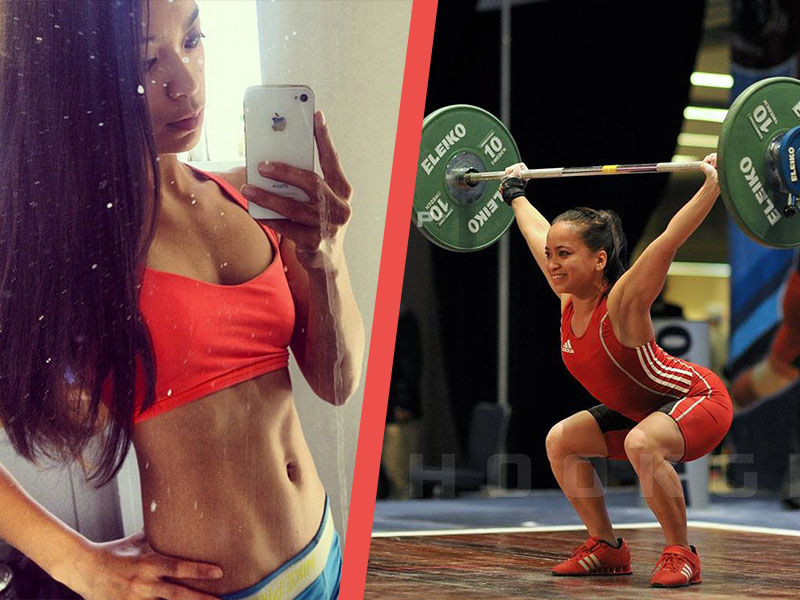
Biography: Erin Parker is the founder of Spitfire Athlete, a women’s strength training app that teaches you how to lift weights, and that stands for the pursuit of greatness & badassery. Spitfire Athlete is made by two female engineers who are also competitive weightlifters. Erin is a software engineer, Stanford graduate, and 48kg olympic weightlifter.
Download Spitfire Athlete: https://itunes.apple.com/app/spitfire-athlete/id822040342?mt=8
Website: http://www.spitfireathlete.com/
Facebook: https://www.facebook.com/SpitfireAthlete
Instagram: https://instagram.com/spitfireathlete/
Twitter: https://twitter.com/SpitfireAthlete
***
I am a weightlifter. I say it with pride. You might not believe it when you see me, because I’m a 4’11” 105lbs woman, and my physique isn’t compatible with most people’s image of a weightlifter. But I am strong and have accomplished a number of physical feats, like lifting over twice my bodyweight, winning a 10,000 push-ups competition (it took me a year), and running multiple marathons.
I started lifting weights entirely for aesthetic reasons. I was phasing out my marathon training, wanted to learn how to squat, and was obsessed with sculpting a six pack, having toned legs, and huge glutes.
“Why didn’t anyone ever tell me this was so effective?” I thought. At the time, I was following Jen Rankin’s Muscle Building Program on Bodybuilding, eating a picture-perfect oatmeal, egg whites, chicken breast diet, and seeing fantastic results. I felt empowered to know that now I have the knowledge and discipline sculpt my body however I like, and I was happily training away at the gym for months.
July 2013: Me taking a progress picture selfie.
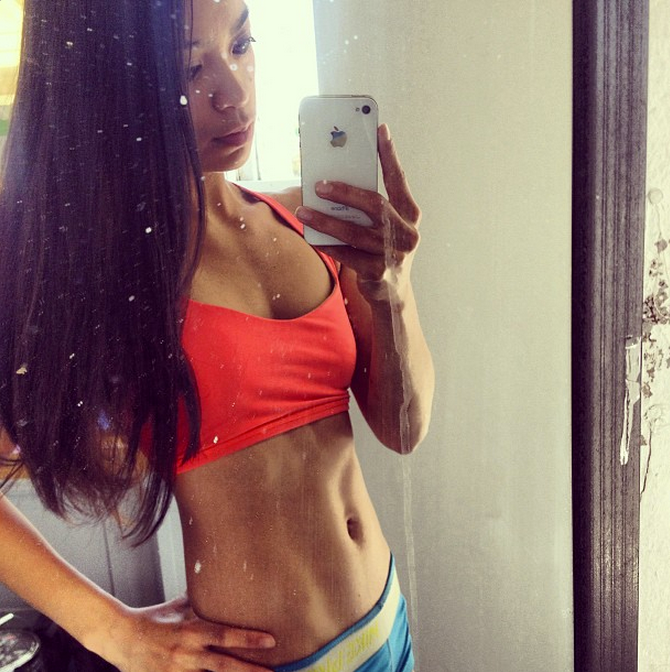
Along the way I discovered Bret Contreras and Kellie Davis’s Strong Curves Book. I wanted to improve my glutes and started incorporating hip thrusts and glute bridges religiously into my routine. And then something interesting happened. I was getting pretty good at heavy glute bridges. So, I got into a small competition with myself to lift more and more on the glute bridges.
I started glute bridging around 85lbs, and would add 5lbs each training day. I didn’t realize at the time that I was basically doing a linear progression, but in a few months, I found myself glute bridging a PR of 205lbs at 90lbs bodyweight, and I realized…I am strong. If I can lift over twice my bodyweight in this way, then I must be physically capable of lifting way more than I realize and doing more advanced exercises.
July 2013: My barbell glute bridge PR of 205lbs for reps!

Shortly thereafter, my gym started offering free personal training sessions members who haven’t previously purchased sessions, and I decided this was a great opportunity to learn the snatch and the clean and jerk, exercises which I viewed as advanced at the time, and which I was ready to incorporate into my routine. I didn’t realize that these exercises were part of the sport of olympic weightlifting. I just thought they looked cool. I also didn’t realize that this session would change my trajectory from casual fitness buff to seriously competitive athlete.
My trainer was Larry, a trainer who happened to be a competitive weightlifter and who was previously a competitive powerlifter.
“I see you around the gym a lot,” he said. “You seem to know what you’re doing. Can you tell me more about how I can help?”
“Can you teach me to clean and jerk and to snatch with a barbell?” I asked.
His eyes brightened up. “You want to learn the snatch and the clean and jerk? I can definitely teach the snatch and the clean and jerk. Ok, let’s go. Let’s see what you can do.”
Larry was very passionate about these lifts, and I was lucky to meet him, because he has been one of the most supportive people who would later encourage me to go after bigger goals and who I would see at many upcoming weightlifting competitions. He was the first person who saw and believed that I could be good in this sport.
My first clean and jerks and my first snatches weren’t pretty, but I got the gist of it, and best of all, they were incredibly fun! I felt like such a badass. At the end of the session he said, “Hey, there’s a weightlifting competition in 2 weeks. Want to do it?”
I didn’t even know weightlifting was a sport. I knew about powerlifting…but this was different. This was the snatch and the clean and jerk. Since they were the most badass feeling exercises I had ever done, I decided…I would do it. It couldn’t be harder than a marathon, right?
Two weeks flew by and I was ready as could be for my first competition. In a weightlifting competition, you have three attempts at the snatch and three attempts at the clean and jerk. Your best snatch and your best clean and jerk count towards your total. The lifter with the highest total in their weight class wins. You compete against weightlifters in your weight class, and for women, weight classes range from 48kg to 75kg+. I currently compete in the 48kg weight class.
The competition went really well, and I had a blast. Walk up to the platform and lift heavy shit? I’m all down for that and I would do it again. I even got more excited about the sport of weightlifting after doing some initial research and learning that elite weightlifters in my weight class are actually around my height.
For example, Wang Mingjuan, a badass 48kg Chinese weightlifter who won gold at the 2012 olympics is 4’11”. Hiromi Miyake is a 48kg Japanese weightlifter who won silver at the 2012 olympics and she is 4’9”. In weightlifting, you actually have an advantage if you are short and have shorter limb length proportions because you don’t have to carry the barbell as high to complete the lift.
Here is a chart from Bob Takano’s Weightlifting Programming book showing height ranges for female weightlifters as part of Leslie Musser’s Master Thesis, pulled from the competitors at the 2009 Pan American Weightlifting Championships.
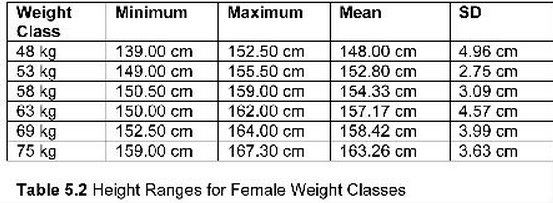
When I noticed that in the 48kg class the minimum height was 4’6”, the maximum 5’0” and the mean 4’10”, it surprised me that my height was in this range! I had the misconception that all weightlifters were tall. This data gave me extra fuel and motivation to participate and compete. I no longer had this fear of being the only small person in the room. There is a weight class for me. I felt like I could belong.
October 2013: Me at my first weightlifting competition.

Here is a video of me at my very first weightlifting meet, hitting a PR of 45kg on the clean and jerk:
My first competition was a wonderful experience. I thoroughly enjoyed it and believed I could be good at it. I liked that my training consistently reinforced the feeling that I was strong and very physically capable.
Here is me at my second weightlifting competition, in January of 2014 (about 3 months later) hitting my then all-time snatch PR of 35kgs:
After testing the waters with a couple competitions, and on a beginner’s high, I decided to get serious and set an aggressive goal. After competing and beating personal bests, I could no longer be happy training the way I used to train. I was hungry. I wanted to be great at something, and I believed this was a sport where I actually have a shot at being great.
I joined a weightlifting team and started working with Coach Bram McArthur of SF Iron. He is both a weightlifting and a powerlifting coach who starts all of his athletes with a linear strength progression of squatting, deadlifting, benching, and overhead pressing. Upfront, I told him my goal was to qualify for a national level competition that year, either USA Nationals or the American Open. At the time, Nationals had a 109kg total to qualify and the Open had a 101kg total. My last meet total was 86kg at the time, so I would have to at least lift an additional 15kg, but I was sure that with hard work and consistency I could get there.
To see how well I was progressing relative to performance benchmarks, let’s look at this Weightlifter Classification System (developed in Eastern Europe), from Bob Takano’s Weightlifting Programming Book. There are six levels in ascending order, Class 3, Class 2, Class 1, Candidate for Master of Sport, Master of Sport, and International Master of Sport.
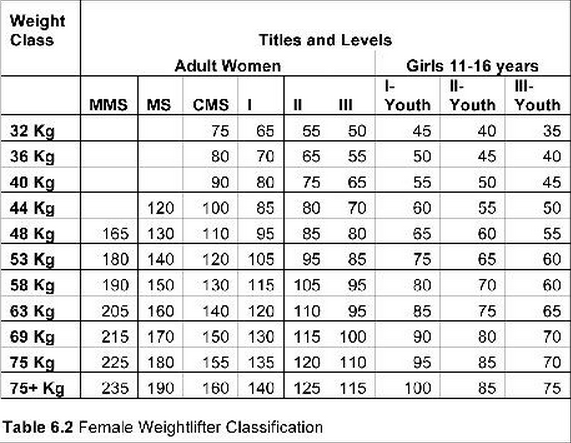
Here is my competition trajectory:
– First competition on October 2013: Sn 25kg, C&J 45kg, total 70kg (Class 3)
– Second competition on January 2014: Sn 35kg, C&J 51kg, total 86kg (Class 2)
– Third competition on March 2014: Sn 43kg, C&J 57kg, total 100kg (Class 1)
– Fourth competition on April 2014: Sn 44kg, C&J 60kg, total 104kg (Class 1) & Qualified for American Open
– Fifth competition on August 2014: Sn 40kg, C&J 55kg, total 95kg
– Sixth competition – American Open – on December 2014: Sn 44kg, C&J 53kg, total 97kg
Like all the athletes who train with Coach Bram, I started with my first linear strength progression, squatting, benching, overhead pressing, and deadlifting three days a week and increasing weights linearly each week. “We need to put some strength on you,” Bram would say…and yeah, he still says this!
After a few months, I couldn’t believe how much I was lifting. Relative to my bodyweight, it was a lot, although relative to competitive weightlifters, my strength numbers aren’t that impressive.
Today, I believe that we all should go through a linear progression at some point in our lives. Regardless of gender, regardless of whether you’re training for health, strength, endurance, or aesthetic reasons, I believe you should go through an LP, because it will make your body stronger, and you will perform better at everything. Of course, there are sports like gymnastics where the athletes don’t lift weights, so in those cases do what your coach says, but if you’re a recreational athlete, a basic LP done in your “off season” to build strength, can transform your body’s ability to move and perform. It’s also really eye opening to see how strong you are in a short period of time. Each training day, you’re lifting more than you ever have before, basically pushing your limits each time. You can literally feel yourself getting stronger.
My numbers when I started:
- Squat 1RM 140lbs
- Deadlift 1×5 140lbs
My numbers after my first LP:
- Squat 1RM 190lbs (1.9x bodyweight)
- Deadlift 1×5 210lbs (2.1x bodyweight)
- Bench Press 1RM 90lbs
- Overhead Press 1RM 80lbs
I had gained 10lbs of bodyweight, so I hit these numbers weighing around 100lbs. Since I was entered the sport weighing 90lbs, I needed to build up to my competition weight at 105lbs, which I had never ever weighed before. In the sport of weightlifting, you want to weigh as close to your weight class as possible, and since I was 15lbs under the lightest weight class, I needed to gain weight to be competitive.
My first linear progression was over, and sure enough, the gains came! Soon after I hit a snatch PR of 45kg. Moving up to the yellow 15kg plates on the snatch felt huge!
45kg Snatch PR:
I competed at the Hassle Free Open and made a competition total of 100kgs, up 14kgs from my last meet.
Here are my lifts from the Hassle Free Open:
43kg Snatch:
57kg Clean and Jerk:
I was 1kg short of qualifying for any national level meets, so I continued my training and a month later, I tried again. I was training 3-4 days per week and my training consisted mostly of snatches, clean and jerks, and squats.
At my next competition, I made a 104kg total, and qualified for the American Open! I graduated to being a “Class 1” lifter now!
Here are all my lifts from the CTS Wine Country Classic in April 2014, where I made a 104kg qualifying total:
I could have stopped there and just focused on the American Open, but being the aggressive, ambitious go-getter I am, I decided to try to qualify for nationals. I was only 5kgs away from the qualifying total. USA Weightlifting even sent me this really nice email to encourage me to go for it, which I appreciated, even though it’s likely automated. 🙂

So what was next? I had finished my first LP, transferred those gains to my olympic lifts, and added 14kg to my total. I almost made my last snatch and my last clean and jerk (which would have given me the total needed for nationals) but missed by a very close margin.
For my next competition, I needed to continue practicing the olympic lifts with heavy weights, but I also needed to continue making strength gains. So my coach progressed me to an intermediate program, the Texas Method for weightlifters. This type of program is appropriate for an intermediate strength athlete and relative beginner in weightlifting. The focus is to keep driving the strength of the lifter while sufficiently practicing the olympic lifts.
My program looked like this:
Monday
Goal: Practice the olympic lifts.
Sn 2×4-8
C&J 1×5-10
Tuesday
Goal: Volume strength work, to drive strength up.
Sq 75% 5×5
Press 75% 5×5
Chins 3×5-8
Thursday
Goal: Check progress on lifts and overall recovery.
Sn max for day
C&J max for day
F Sq 3×3
Sat
Goal: Check progress on strength and overall recovery.
Squat 1×5
Press 1×5
DL 5×1
The volume day was by far the most challenging. I had to do 8 sets of 2 snatches at 90%+ range followed by 15 clean and jerk singles also in the 90%+ range, with a maximum of 1-2 minute rests in between each set.
Here is a video of me doing (aka struggling) through the Texas Method program: https://instagram.com/p/qGHJdxIIwG/?modal=true
At first I thought, “This is freaking insane! Is it physically possible to make so many lifts at 90%+?” Not only that, I had to increase the weight with each lift, even if I only increased it by half a pound. Practice was long and difficult. I would barely have a chance to catch my breath, I would be dripping sweat, feeling like I barely had it in me to continue…and then I would have to push myself even harder and lift even heavier than my last rep.
My first week, I would miss lifts left and right. When I was “failing all the time” I felt like I didn’t know what I was doing. But I kept on and gave it my all, even if it felt sloppy. Then…something kind of magical happened. After about a week or two of training at this level, my body adapted. And so did my mind. I suddenly started making these snatch double at 90% of my capacity. I also no longer got so tired, mentally, and was able to stay focused through the entire 8 sets of 2. My technique also started improving, probably because of all the practice, and it was an amazing feeling because I started actually making heavy snatches more consistently.
July 18, 2014, A video of me making heavy snatches more consistently: https://instagram.com/p/qnADKfII8T/?modal=true
On my heavy strength days, I found myself squatting 180lbs for doubles…like it’s a totally normal thing. I remember sharing a squat rack with a guy when I was at a commercial gym once. I had to do something like 185lbs for a double. He was squatting around 135lbs, and when I started warming up into the 150s, 160s, he started trying to squat way outside of his comfort zone just to try and keep up with me. Why? I have no idea. And then he started really struggling at 165lbs. When I finally did my last warm-up at 175lbs and my work set at 185lbs he said, “Oh my god. I can’t even keep up with you.” He was flabbergasted. I laughed and thought to myself, “Of course you can’t!” 😉
I competed in the Tommy Kono Open that summer. It was my worst competition ever for two reasons: 1) I had to cut weight for the first time and 2) I was a complete nervous wreck. I was very care free with my diet in the months before, using my hard training as an excuse to go all out, and now I was well over my weight class. Darn.
Cutting for the first time was tough because I felt extremely energy-deprived and like there was nothing in my muscles. On top of that, I was a nervous wreck because in my mind, this meet was a really important competition and I didn’t want to fuck it up. I wanted to qualify for nationals. This was my last chance! But I was so nervous that I was basically hyperventilating in the warm-up room and I felt like my heart was going to explode out of my chest. In my mind, I kept worrying, “Oh my god what if I fail my opener? What if I don’t make the total? All my hard work will be wasted!”
I even missed my 35kg warm-up snatch. My coach immediately knew something (more like, a lot of things) were really off. Because of the cut and my mindset at the time, the bar felt really heavy, when it shouldn’t have. I only made my opening snatch and my opening clean and jerk. Even though I ended up medaling at the meet, I didn’t make the total I had wanted, and felt like a failure.
Here is what I learned: First, I want to resume having a great diet and stay close to my weight class, not go over too much, and avoid drastic weight cuts. Second, I want to get my mental game together. I want to learn how to not be panicking on the day of competition, and to stay calm, composed, and ready to perform.
A lot of things happened in the next five months after this meet and before the American Open. My start-up, Spitfire Athlete, received investor funding from one of the top accelerators in the country and my co-founder and I flew over to Boston for three months to aggressively grow and build the company.
We had an aggressive schedule, where I had meetings all morning and would code all night, and work with my co-founder towards shipping an app update every week. We didn’t even lift for the first couple of weeks of the program, because things were so crazy and we were barely sleeping.
When our schedule calmed down just a little bit, we managed to get some time to lift at the MIT gym, basically the only affordable gym in the area that we could reach via public transport that had a platform, olympic bars, and bumper plates. But I really struggled. After not lifting for a few weeks, my technique was all over the place, knees caving in, pressing out, and I felt so weak. I completely deprioritized my health, nutrition, sleep, and weight training in order to hit aggressive goals. I remember lifting on days where we only had 6 hours of sleep and where I struggled to make a 40kg snatch.
I reasoned that “this was only going to be for three months, I’ll gain everything back when I’m back in San Francisco” but I didn’t realize it would take months to gain back strength that I had lost in a few weeks. If I were to do it again, I would take the more long term approach and better balance my training with more focused company milestones (because really, we didn’t have to do it all, we just really wanted to).
Nov 2014: Me and my co-founder in Boston, celebrating Spitfire Athlete’s 1 year anniversary. Two women on a mission to make strength training a part of every woman’s routine.

As Techstars came to an end, we had achieved some very meaningful goals, like our 50,000+ users worldwide, hitting our engagement goals (did you know that most workouts tracked on our app are over an hour long?) and ranking in the top 10 for App Store search results like “women’s fitness” and “women’s strength”. We had the most fun pitching to a theatre full of investors and ending our presentation with a clean and jerk. When we talk about badassery, we mean it.


It was close to the end of November 2014. I was back in San Francisco, and training at my coach’s shiny new gym, SF Iron. Squat racks, platforms, and barbells for all! The American Open was in less than one month! My coach advised me to start visualizing having successful lifts. He recommended visualizing me getting nervous, and then controlling my nerves and then executing the lifts well. I did some additional research on the subject of athletic performance visualization and found a book called 10 Minute Mental Toughness.
I read it and decided to give it a try. I would meditate every day, either first thing in the morning or right before practice.
In the first part of the meditation, I would start by taking a deep centering breath. Then, I repeat my performance statements to myself. Here is part of my performance statement: “I have what it takes. Today, I am going to give it my all. I am going to give it every single fiber of my being. I am going to finish strong.”
I would repeat this to myself until I started believing it. And then I would imagine myself at the American Open and getting ready to make my opening snatch. I would imagine feeling nervous, seeing the loaded barbell on the platform, and then imagining myself taking a deep breath, clutching the barbell in my hook grip, and then in slow mo, making the lift. I would imagine myself smiling and the audience cheering at the end of the lift. I do this three times for the snatch, three times for the clean and jerk, imagining myself making the lifts, no matter what. I would imagine myself pushing through and finishing strong on the jerk.
I finished by reciting my entire performance statement again, and then taking a few deep breaths, and then I was out.
I did this meditation every day in the weeks leading up to the competition. I started noticing that it also had an immediate effect on my confidence in practice. Within the first week of doing this, I already started making more of my heavy lifts, particularly my heavy snatches which is what I was the most afraid of.
Now that I was actually visualizing making these snatches more than I was visualizing failing these snatches, I actually started making them! It was quite eye opening, actually, to realize that in the past I was actually visualizing failure more than I was visualizing success.
Before I knew it, I was on a plane and flying off to Washington DC for the American Open, my first national level competition! Since I had recently gotten back from Boston, my strength numbers felt nowhere near where they were earlier in the year, so my focus for this competition was to give it my best mental game and to make my openers. Anything after my openers was icing on the cake.
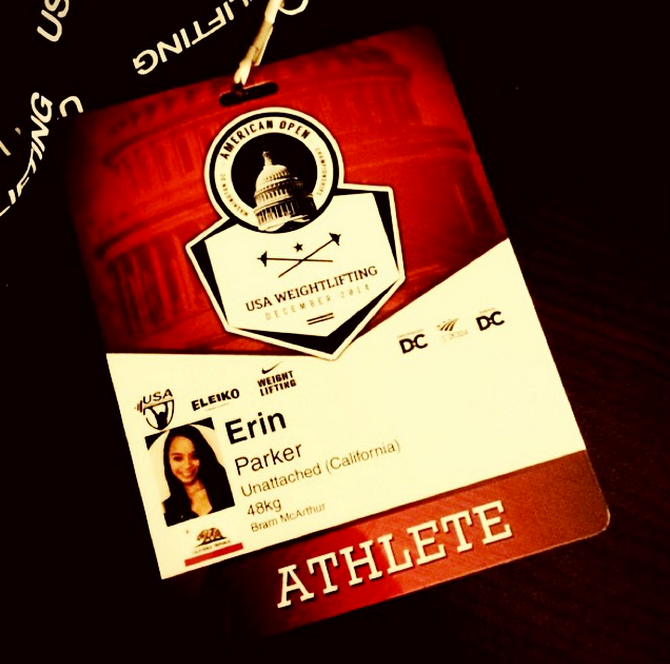
On the day of the meet, I was up at 6:45am, ready to weigh in by 7am. Yes, I was very nervous. But I think the meditation practice really did pay off, because I wasn’t a complete nervous wreck, and my focus was on making my lifts, and nothing else. Mentally, I was unshaken. Yes, I could still feel my heart beating hard, and my breathing was a little fast, but I kept a focused look on my face and I knew I was going to make it through without panicking.
I made my opening snatch – easy. It felt GREAT. It felt light. I felt strong. Then, I made a 44kg snatch and it also felt solid. I could even hear my mom and my grandma cheering me on from the audience. This was their first time ever seeing me lift!
After my snatches were over, I felt a huge sense of relief. I had gotten over the scariest part of the meet! I thought, “Wow. I was able to get control over my nerves and perform when it mattered.”
Although I finished all my 3 clean and jerks, the judges only counted the first one. My last two were disqualified for press-out, unfortunately. However, it was, by far, my best performance ever, because my mind was in the right place. I felt fantastic. I was cool, composed, and when I did my lifts, I felt confident.
One of my favorite parts of going to this meet was getting photographed by Hookgrip. I had dreamt of getting photographed by Hookgrip one day, and here it was!
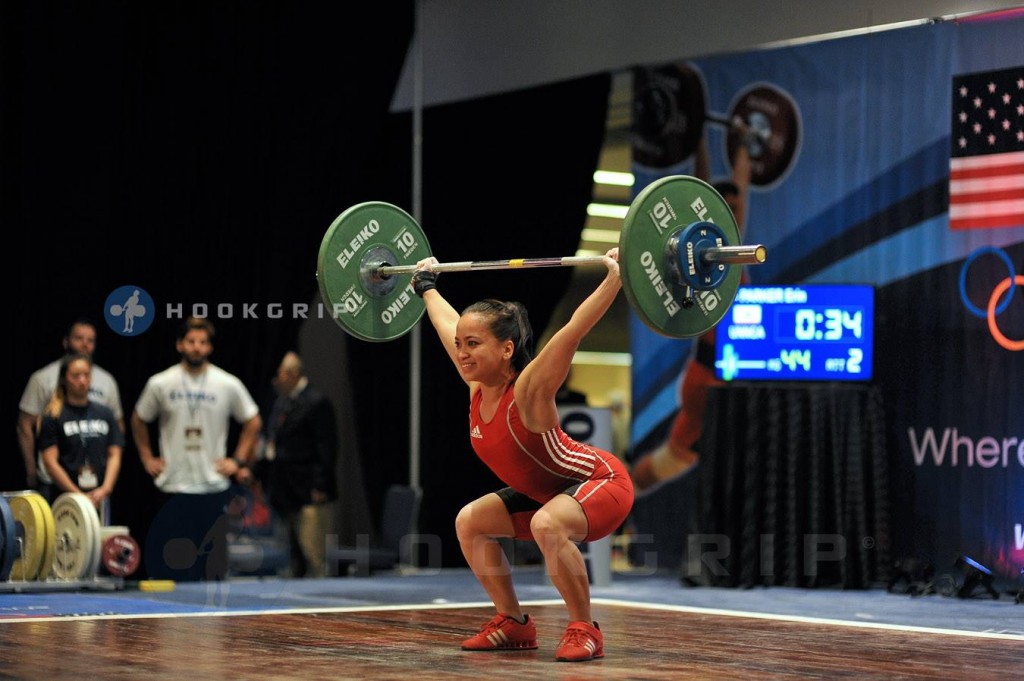
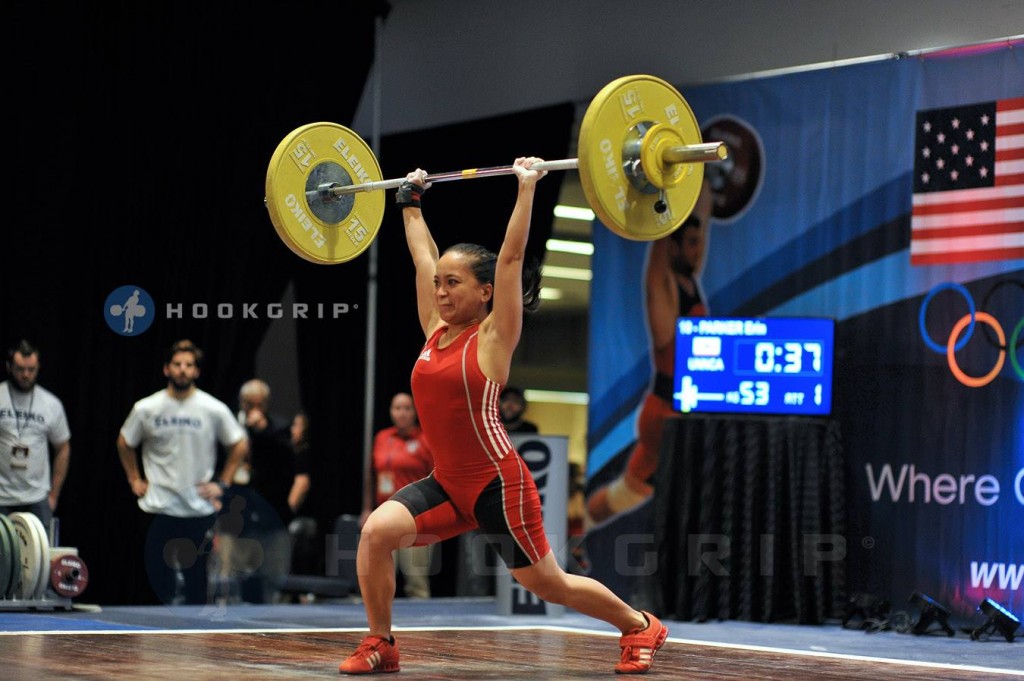
I’m excited to continue onward with this journey and to push myself year by year. I love this sport and can’t describe how much fun I have.
As I write this, since the American Open, I have achieved new PRs, namely, a 50kg snatch (hell yeah for the beyond bodyweight snatch), a 63kg clean and jerk, and 78kg front squat. If you go back to the chart from earlier, this in-practice total would allow me to graduate from “Class 1″ and make it to “Candidate for Master of Sport”. Now I just got to take this performance to my next competition.
What’s next? Well, this year, I’m going to try to qualify for Nationals and the American Open again, although this time the qualifying totals have increased to 133kg and 123kg, respectively, so I’ve got to keep on training, working hard, giving it my all.
I feel stronger than ever. If you’re thinking about competing in the sport of weightlifting, I say go for it! Give it a try. You’ll never know, you just might fall in love with feeling like badass every day and never go back.
I’ll end this with one of my favorite quotes by Mia Hamm: “Somewhere behind the athlete you’ve become and the hours of practice and the coaches who have pushed you is a little girl who fell in love with the game and never looked back… play for her.”






Congrats on your great growth. It has been my dream to be a lifter. And for silly reasons I have kept putting it off. After reading this I have got the fire in my belly yet again. And plan on pursuing my dream.
Best of luck for your future in the sport.
Truly one of the most inspiring things I have ever read about the sport. I am deeply moved, and I don’t know why. I am an 18 year old female, recreational athlete at the moment. I have previously competed and done well in track and field events, but turned to full time lifting a few months ago. This is a wonderful story. I will read it often. And I’m only commenting a few years after the post. 😛 pardon me.